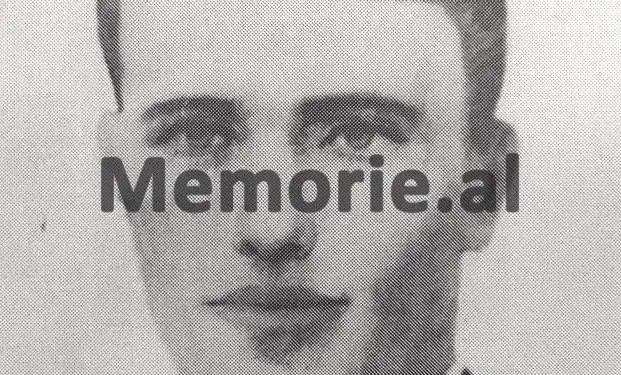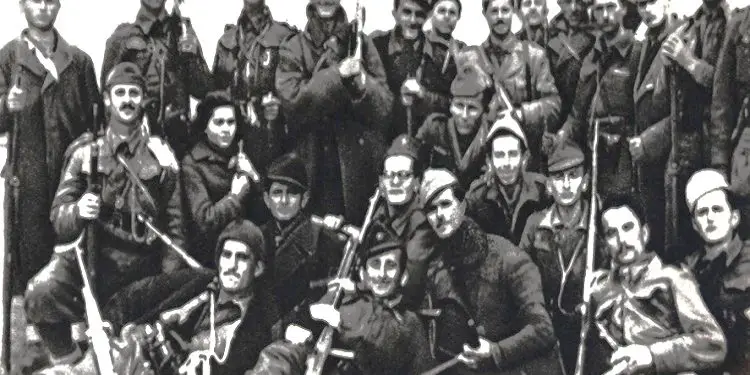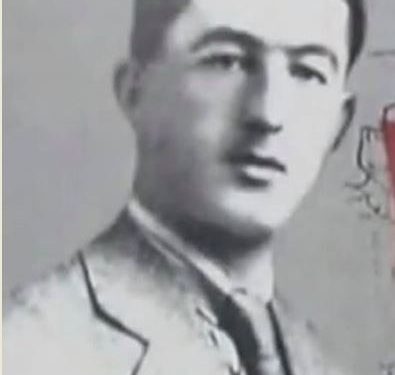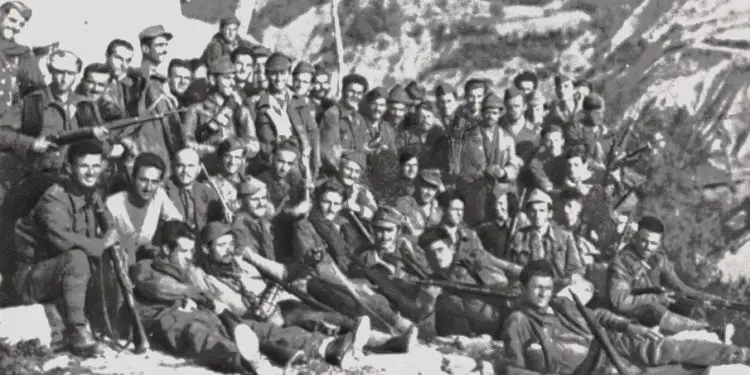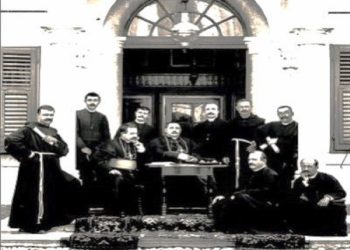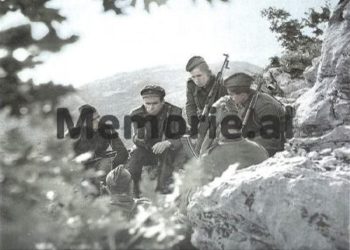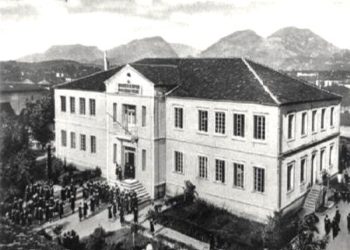Memorie.al / A book has been written, “Pse e vranë Odisenë” (Why They Killed Odysseus), by Anastas Kondo. Reading it, I found some parallels between the murder of Odysseus and that of Neki Ymeri. “Who killed Odysseus?” they ask Mother Katera (Katerina), the elderly woman from Vuno, a great poet and historian. “His own people,” was the answer, “the Spiromilaj, connected with the Greater Greeks. Don’t ask who killed him; ask who ordered it, not who carried it out!”
Neki Ymeri was also killed by his own, those connected with the Greater Serbs, those who conceived the idea. Where was Odysseus killed? “In the Gorge of the Beast, in an ambush, hidden, from behind, treacherously, on a scorching day.” Neki was also killed in an ambush, at the Wolf’s Stream (“The Lady’s Bridge”), on August 27, 1943, in a hot situation, both meteorologically and politically.
How old was Odysseus? “Why ask? Twenty, whether he was or wasn’t, or a little more.” Neki Ymeri was also 24, almost 25 years old. What had Odysseus done? “He had brought vivëlla (books), close to his chest.” Neki too was fighting to bring freedom, which he carried close to his chest, in his heart. The parallel is broken later.
The author says: “I saw Odysseus’s photograph in the village museum, lined up with his friends, all handsome.” Whereas I never saw Neki Ymeri in my village museum, nor those of his comrades, each more handsome than the last!
Anniversaries were held for the “Old Band” of Gjorm, but Neki Ymeri, the legendary commander, and his comrades, all handsome, were never seen! When an anniversary of the Gjorm War was held in 1983, I also went to my village and listened for two good hours to the First Secretary of the Party, a lawyer, who beat around the bush and often skirted the issue, and not one word was said about Neki Ymeri, and little or nothing was said about the people of Gjorm.
Earlier in Tirana, a historical scientific session was held at the House of Military Officers, and those who had survived the National Liberation War and the execution of 1975 presented papers, where it was said: “… terrain for the ‘Old Band’ to be formed existed throughout the Vlora River region, but it was formed in Gjorm, quite by chance.”
And I, as an educated but immature young man, stood up and retorted: “Terrain for the formation of our Party existed everywhere, but it was formed in Tirana, because the subjective element was there!” (the people, the cadres).
But without delving into the fact that the parallel would imply that in Tirana, Enver Hoxha and his comrades were operating, and in Gjorm, Neki Ymeri and his comrades. A former General from the Vlora River region, who had survived the execution of 1975, asked me: “Where are you from, son?” “From Gjorm of Vlora,” I said, choked up. And he: “You are right!!!” I waited for some kind of punishment, but surprisingly, they judged it to be youthful naiveté and immaturity that could be forgiven, or perhaps because the General and I had neighboring villages.
A lot has been written about the murder of Neki Ymeri, “Vangjo,” the commander of Vlora’s “Old Band,” but his “black box” has not yet been found?! According to traditional skeptics, he was killed because: “he did not follow Enver Hoxha!” But Neki’s ideal was freedom, the homeland; he fought for it, and for it he could even be killed and would definitely be its martyr. According to neo-skeptics: “he was killed because he met Hysni Lepenica.”
But Enver Hoxha also met Hysni Lepenica in Dushkarak and invited him to become a member of the Communist Party. Neki Ymeri, “Vangjo,” was the commander of the “Old Band” of Gjorm (Vlora) from its formation in September 1942 until his murder on August 27, 1943.
It was named the “Old Band” of Gjorm because it was formed in Gjorm, Vlora, with fighters from that village and the surrounding region: Mesaplik, Tragjas, Vlora, Mallakastër. Its sphere of activity spanned the Vlora-Fier-Mallakastër Prefecture, and even further, up to Peza and Babë Myslymi.
He was killed at ten o’clock, on August 27, 1943, in a hot meteorological and political situation, at the place called “The Lady’s Bridge,” between Gjorm and Lepenica, in an ambush and by surprise. He was killed along with Xhafer Dalani, also from Gjorm, a freedom fighter with the pseudonym “Shpuza” (Sponge)!
Both were great fighters, one a commander and the other a soldier. And regarding this murder, Babë Myslymi, who had known Neki in Peza, when he had gone to coordinate actions for the release of the Political Secretary of the Vlora Regional Committee, Sinan Gjoni, when he was to be transferred to Tirana, had said: “… a brave man is not the one who kills you in ambush, without calling you out.”
And this saying was not deciphered, even though it was uttered in the very days Neki was killed. Baba repeated it later in his memoirs, just as he had said it before.
In Gjorm, they say that when Neki was killed, his father, Ymeri, held his hands clenched into fists until he died, as if to withstand the pain of losing his son, or to silently say, like Migjeni: “Oh, how I wish I had a powerful fist, to strike the unyielding mountain right in the heart!”
And his murder was accompanied by pain and silence for 57 years, 1943-1990. In a quick, transient, indifferent view, all deaths are like this and cause pain. But looked at more attentively, there are some gradations within them.
There are natural deaths, “white” ones, and there are deaths that take your life, even violently. Legal experts write that after violent deaths, there are three links: the Ideator, the one who ordered it, and the one who carried it out. By the Kanun (traditional law) once, both in the North and South of Albania, when the custom of vendetta was active, the matter rested with the one who said “he must be killed,” the ideator.
But when murders are treacherous, in the darkness of night, of the innocent, the deaths are many times more painful! The murder of Neki Ymeri was the murder of the century, because a legendary leader, the commander of a regional band, was executed at a young age, 25 years old.
75 years have passed since his painful fall, as for any death, for a young man, a fighter, a patriot. In a letter he left, a self-criticism, Neki wrote: “I fought the war, and I followed the line of the National Liberation.” That would be enough to be called an analysis.
He was the boy who was wise in behavior, golden in knowledge, and fervent in the field of battles. He was an educated man for the time, a frontline fighter, a type of military general, who commanded and fought, who carried the strategy of a commander and the automatic rifle of a soldier.
In a photograph, which must be more of a retouch than an original, which has been mounted in several books and newspaper publications before, Neki looks like an older man, while in a photograph found later, Neki appears with all the beauty and youth of himself, with all the elegance of European clothing, with an upright posture, sitting in a protocol manner, dressed in the same way, with a tie, with a broad forehead and captivating eyes, well-groomed (look closely!), holding his head high, black hair, a slightly broad and sympathetic beard, who, as the poet Fatos Arapi, who had known him, says: “Neki Ymeri left me with great impressions, with his physical appearance, handsome, a mythical figure of the Lab.”
With the victory of the Battle of Stalingrad, Hitler had been overthrown, and had even dismissed the great General Rommel, and the East had guaranteed victory, and the leaders of the war had begun to think about the future, about their power, and had begun the witch hunt. It was precisely at this moment that Neki Ymeri was killed.
Stalin had said: “Marx has taught us that the Party lives only through purges!” Neki had graduated from the Harri Fultz Technical High School in Tirana as a surveyor with matrix number 906, had taken lessons in Korça for global engineering, worked as a surveyor in Saranda, in Vlora, and was involved in the guerrilla movement.
In fact, his name had been declared wanted, as a person who was causing losses to the power of the time and had to be arrested as dangerous. In the early part of 1942, he was a member of the communist nucleus or cell formed in Gjorm, with Hysni Kapo, for Mesaplik, he was involved in the formation of the power nucleus in the region, he was a leader and later commander of the “Old Band,” he was the elected secretary in the youth of the Vlora-Mallakastër-Fier Regional Committee for the village, and Qemal Stafa also says this: “In Vlora, they elected Kastriot Muço, Neki Ymeri, Zyra Radhima, Ymer Veshi as secretaries of the regional youth committee.”
All these functions he carried on his young shoulders, and he coped with them thanks to his wisdom, education, bravery, and above all, thanks to his kindness, he carried them out successfully, he was the boy whom everyone loved, and everyone followed, they had faith and saw the future of the war in his eyes.
Who was near “Vangjo” and did not hear his voice in the Vlora River region and in Labëria, that thrilling voice in the call to arms and charming in speech, who marched with him and did not see the stride of the deer and the flight of the eagle over the enemy, who did not recognize the beauty of his angelic face and his big heart, who did not hear the thunderous burst of the automatic rifle over the enemy, at the Gjorm Bridge, in Gjorm over Halil Alia’s mercenaries, in Selenicë, at Qafa e Pëllumbit, in Uji i Ftohtë, in Sirokëmba, in Kallafet, in Radhimë, in Tragjas, in Mal të Bardhë, Mallakastër, Mavrovë?
A total of over 21 actions. Babë Myslymi had highly valued the bravery of that boy (Neki), and had said: “I found the Kajo Karifili of Vlora!” “But the situation in Vlora,” General Vehbi Hoxha, who was accused of factionalism for a lifetime, would write, “is bogged down in a mess, and the first one doesn’t understand the second.”
In Vlora, Mehmet Shehu had also suddenly appeared, with all his ambition for career, and Hysni Kapo was also there, who was the pillar of the movement for freedom, and Neki Ymeri was also there, one of the undisputed leaders of the future state.
But what do they remember about Neki Ymeri, the commander of Vlora’s “Old Band,” first in a whisper, and later articulating it, even loudly? Fatos Arapi gives his portrait: “Neki Ymeri left us a great impression, for his physical appearance, blond-haired, white-faced, a mythical figure of the Lab” (Diary). Kristo Themelko: “I was very happy about the murder in the Gjorm ambush… but it was not so.
Those from Vlora, whom we have here, told me that it is not true, that ‘Vangjua’ was killed” (“Shule,” A.Q.SH., Year 1943, fund 14). This, “Vangjua” (!) somehow sends a shiver, to him and to us, even today as we quote it. And this conveys as much pain as it does high regard for him. Mehmet Shehu, Berat: “The murder did not have good outcomes!” (Berat Plenum, 1944).
Meaning that not everyone was killed, or that those who should not have been were killed. Rrahman Parllaku: “I did not know ‘Xhepi.’ But I dearly loved Vehbiu, ‘Vangjon'” (Book ‘Mirënjohje,’ Tirana 2007, p. 81). Vehbi Hoxha: “Those who were tasked to guard them (in Kutë) shot at them and… killed them!” (Book ‘Kujtime,’ cited). Shamet Gjika: “Vangjua and Xhemili (Çakërri) rebelled, Idrizi and his comrades shot them” (“Ditar i kohëve me gjëmime,” 2005, p. 83). Idriz Seiti said in his trial in 1983: “I carried out the party’s duty.” But he later released another testimony, that he had no plan to kill them. Prof. Xhemil Çela: “Neki grabbed Idrizi’s arm and escaped wounded in the hand” (“Kujtime,” Tirana 1998, p. 134).
Naturally true, this is also said in Gjorm, that Neki escaped thanks to his own agility. Sadik Sinani: “Coming from Krivova, I found someone on the road crying and shouting: ‘Ah, Vangjo, Vangjo!'” In fact, someone writes that Neki’s father, on the day of the burial, supposedly said: “You did as I instructed. You betrayed neither life nor friend”!!!
I do not wish to believe this and do not believe it was said. To write about the legendary man, about the glorious commander, about the son of Gjorm, of the Vlora River region, of Labëria, about the patriot, who never laid down his rifle for freedom, for Neki Ymeri, is as much a duty as it is difficult.
It is difficult because it was not understood why he was killed, the “black box” of his murder is still unsolved. It is a duty because he was left in oblivion for fifty years. But never and in no case was anything said against him. He was not even a particle distant from the struggle for freedom, from the National Liberation, whose line was his.
If there was a front, for Neki Ymeri, it was only the Front of War against the occupier. He is a great figure of the War, and it is difficult to grasp the entire grandeur and brief but great content of his time, great as an entire era. Neki Ymeri was the youngest among the great, and the greatest among the young. Memorie.al





